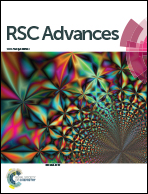A non-covalent interaction of Schiff base copper alanine complex with green synthesized reduced graphene oxide for highly selective electrochemical detection of nitrite
Abstract
A novel and selective nitrite sensor based on non-covalent interaction of Schiff base copper complex [Cu(sal-ala)(phen)] with reduced graphene oxide (RGO) was developed by simple eco-friendly approach. The morphology of the prepared RGO/[Cu(sal-ala)(phen)] nanocomposite was characterized by scanning electron microscopy (SEM), ultraviolet visible spectroscopy (UV), electrochemical impedance spectroscopy (EIS), energy dispersive X-ray spectroscopy, X-ray diffraction studies and Fourier transform infrared spectroscopy (FT-IR). On the other hand, the electrochemical studies of the prepared nanocomposite was investigated by cyclic voltammetry (CV) and amperometric technique. The RGO/[Cu(sal-ala)(phen)] nanocomposite modified glassy carbon electrode (GCE) exhibit the higher electrocatalytic activity towards detection of nitrite. Moreover, the RGO/[Cu(sal-ala)(phen)] modified GCE was determined the nitrite with low detection limit (19 nM), broad linear range (0.05–1000 μM) and high sensitivity (3.86 μA μM−1 cm−2). Besides, the proposed sensor shows good selectivity, repeatability, reproducibility and long term operational stability. The appreciable recoveries was achieved for the detection of nitrite in water and sausage samples, which imply the practical feasibility of the modified electrode.



 Please wait while we load your content...
Please wait while we load your content...